|
|
|
|
This is highly irregular...
|
In the previous section we worked with a pendulum and found
that the actual behavior was only approximated by the simple
equation, p=A*sin(t) . In fact the actual
solution to the pendulum differential equations has infinitely
many terms in it. That is because the force tending to restore
the pendulum to the equilibrium point is non-linear. Gravity
pulls straight down and the pendulum bob swings in an arc so the
restoring force is weight times the sine of the displacement
angle. The sine function of course is non-linear.
Now we will examine Mr. Duffing's oscillator. An
"oscillator" by the way is anything which moves but
remains in a our vicinity. All the dynamical systems we will
discuss are oscillatory in nature. Think about it. If they were
not, the moving parts would just disappear over the horizon,
never to be seen again, and so the system would not be of much
interest to us. Remember we are in the future predicting business
and once something is gone out of our observation and will not be
back, even if it has fantastic adventures, we will not know
it.
This apparatus was explored by a person named Duffing back in
1918 so we call it Duffing's mechanical oscillator (DMO). It
consists of a light metal bar, hardly more than a thin strip,
attached at each end to a solid support. Near the middle of the
metal bar is an electro-magnet powered by alternating current. As
the current in the magnet goes through a cycle, the magnetic
field couples energy into the bar, causing it to move. The
movement is a flexing of the bar. Run the
Duffing's Oscillator, Real Space view
display for an illustration.
|
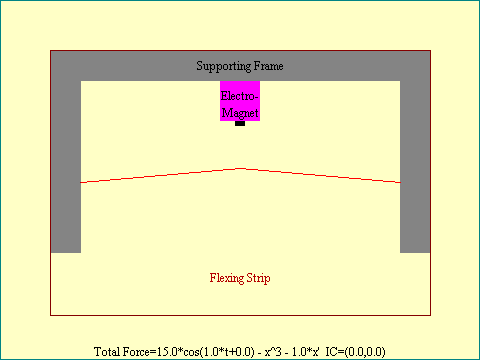
|
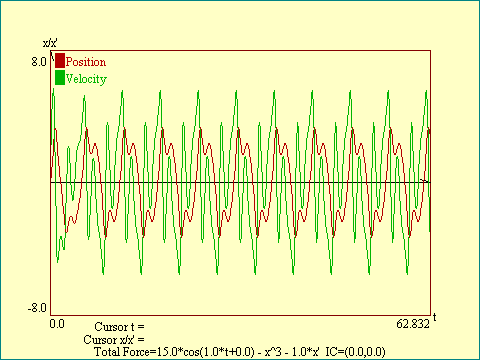
|
As the bar in the oscillator flexes, the position of the
midpoint may be used to measure the amount of movement. Since the
bar is tightly suspended between supports that may be considered
immovable, any transverse displacement of the bar must stretch
the bar material. Metal is not easily stretched so there is a
strong force tending to snap the bar back from any displacement.
This force is proportional the displacement cubed. Energy is lost
each cycle to air resistance and internal heating of the bar.
Energy is added by the electromagnet, exerting force on the
bar.
The frequency of the current energizing the magnet is taken to
be fixed for the time being. The "amplitude" or
strength of the magnetic field is one of the control parameters
of the system which can be varied. The other system parameter we
control is the rate of energy loss. We call this parameter the
"energy loss coefficient" or "drag". In
addition to the system variables of amplitude and drag, we may
vary the initial value of position and velocity. These values
relate to the particular experiment rather than to the system
itself. Run the
Duffing's Oscillator, Position/Velocity vs. Time View
display.
|
|
Remember that we examined the motion of the pendulum in phase space, a space
spanned by position and velocity. In the driven pendulum case, the motion
settled out on an attractor that would be nearly elliptical in the phase space
projection view if the energy loss and gain per cycle were small. The DMO under
the conditions established for the
Duffing's Oscillator, Phase Space Projection View
also settles to a limit cycle consisting of one orbit per cycle period.
Its shape is more complex than the simple ellipse of the pendulum.
Notice that the initial conditions, at the origin, lie quite a way from the
attractor so that it takes somewhat more than a cycle form the electromagnet
before the oscillator finds the attractor. The color change after this startup
transient dies away marks the actual attractor.
|
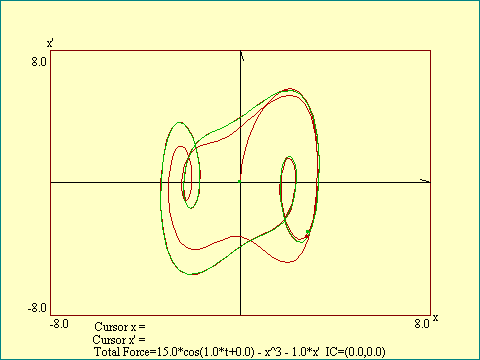
|
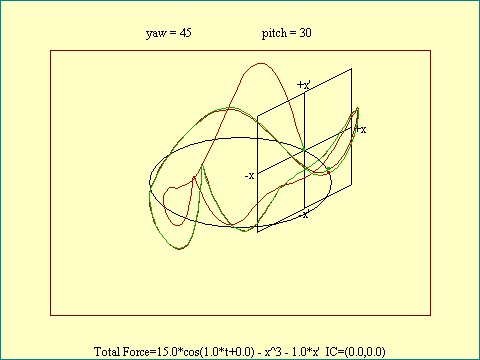
|
In the case of the pendulum phase space orbit, including the time dimension,
where the orbit cycle time was adjusted to match the pendulum period, we found a
fairly simple curve representing the attractor for the pendulum. The
corresponding attractor for the DMO is quite a mess in 3D phase space. Run the
DMO, Phase Space Orbit View to see it. As with the
phase space projection view, the image shown here includes a color change to
highlight the actual attractor.
|
|
Enough about the
innovations of the Duffing Oscillator display, let's get back
to the thread of the story. Looking at the
Position/Velocity vs. Time view,
notice
how jagged the plot is. The motion of the strip is evidently more
complicated than the pendulum. The motion is still periodic
though. It repeats with some definite period. It may be difficult
in this view to determine that the plot does not show subtle
difference between states in successive cycles. As we will see
later, patterns that look somewhat like this actually never
repeat. Compare this time series plot to the one above. Notice that they differ
in the first few cycles but after that are similar.
|
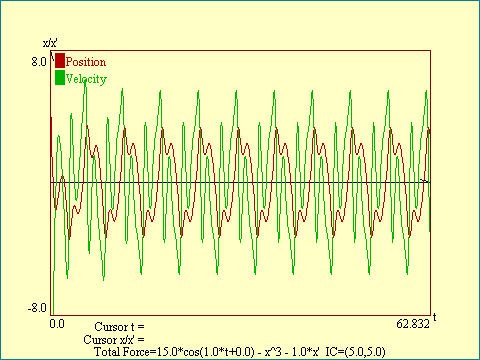
|
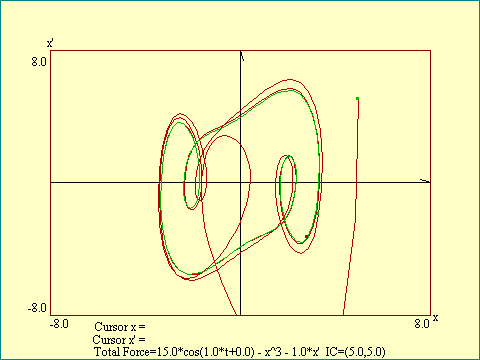
|
To confirm that we have periodic motion here, look at the
Phase Space Projection view
view. After the startup transient the projected orbit is quite stable. Notice
that we started the DMO for different initial conditions than in the previous
models but that the attractor is the same. That is the nature of an attractor,
it gathers up motion started from many different initial conditions. Many but
not all, as we will see.
Also notice that at one
point on the orbit of the states in phase space there is a
differently colored marker. This marks the chronon at which the
forcing function returns to its initial value or one cycle time.
This is called the return point and since only one return point is marked,
we know that the motion
completes its cycle in the same time that the forcing function
completes its, so we have a "period 1" kind of motion.
We will see examples of other periodicity later.
|
|
The Phase Space Orbit view of this
dynamical system again reveals that there is only one loop per
cycle of the forcing function. Granted it is a warped looking
affair, but still it only completes one circuit of the time axis
each cycle. To verify this pitch up to 90 degrees so the
variations in velocity do not complicate the picture. Notice that
this view also marks the return chronon in the distinctive
color.

Are there any questions?
|
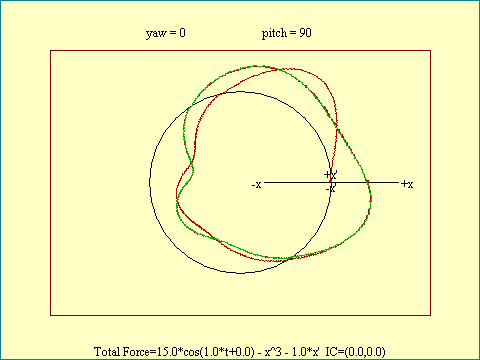
|

 Next
Next
 Previous
Previous
 Other
Other
|
|
|
|




